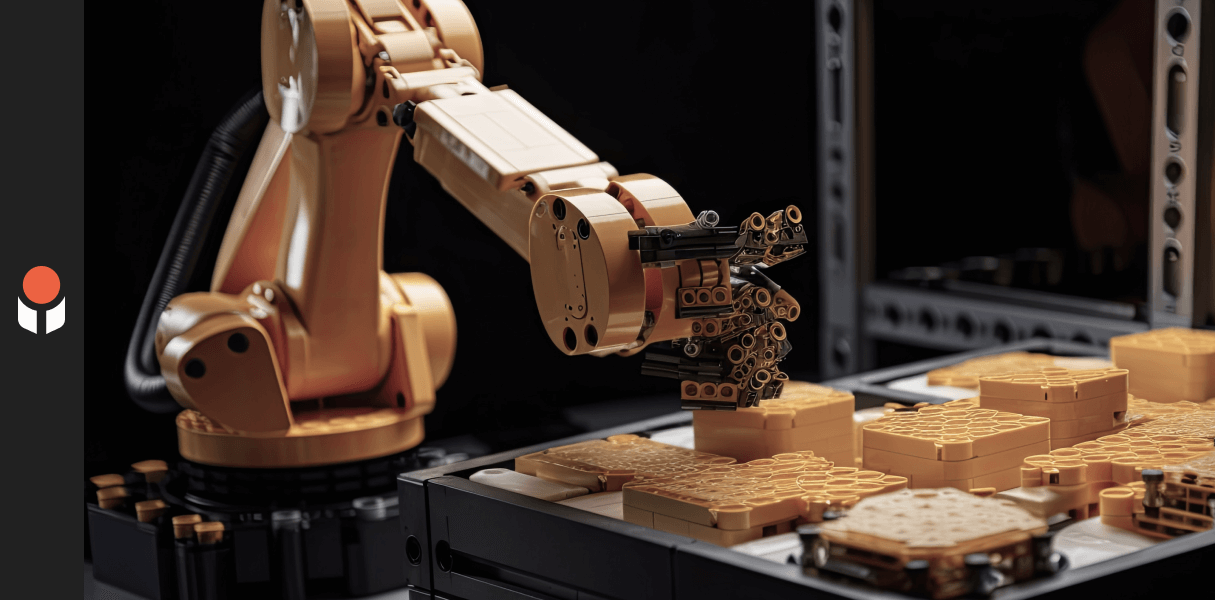A Random Bin Picking Case Study
Automated Random Bin Picking Solution Provides Safety & Process Optimization
Automating labor-intensive factory tasks with the use of bin picking robots prioritizes worker safety and increases profit.
The problem
At a truck and axle manufacturing plant in North Carolina, an operator was tasked with unloading heavy, irregular parts from a 42” x 48” bin. The job required a worker to reach into the giant 30-inch deep bin, pick out parts one-by-one, and transfer each to a re-gripping station. Up to 20 inches long, the truck axel and brake components could weigh up to 25 pounds. When one part is laying on top of another, 25 pounds suddenly becomes 50 pounds. Due to the random nature of the bin, the task was complicated, demanding, and posed many hazards to factory workers.
Safety Risks
In attempting to protect workers from a specific danger or risk, industry standard safety equipment such as hand protections can actually impede the worker’s ability to complete the task in a timely fashion, and in some cases can even increase risks or introduce new hazards. Safety gloves are made to protect people from workplace hazards including cuts, abrasion, heat and cold. Whether supported or coated, gloves can make it more difficult to pick up and maintain a solid grip on the pieces, increasing the likelihood of dropping heavy parts, bodily harm due to unstable strenuous labor, and part and equipment damage.
Tasks such as unloading bins or bulk parts sorting are monotonous and labor-intensive. When the parts are heavy, sharp, rusty, and irregular, the task becomes hazardous, impeding worker safety. With the technological advancements available today, factory operators need never be put in dangerous situations. Opportunities to install smart, safe robotic solutions are quickly becoming a feasible reality for manufacturers whose goals are to prioritize worker safety and increase business profits.
The Solution: Random Bin Picking
Compared to structured and semi-structured bin picking, random bin picking is a complex process, requiring a robot to be able to make difficult real-time analytical and spatial decisions. Random objects may not weigh the same amount, may overlap, or lay in inconsistent orientations. Once one part is successfully removed from the bin, all other parts shift, creating a new and unique landscape after every pick cycle. Additionally, a robot must decide which part not only is the easiest to pick up, but how to move the object without colliding with the bin and damaging the part or damaging the arm tooling. To a robot, this scenario is chaos.
The human brain can intuitively and instantaneously judge a disorganized environment and decide on how best to proceed. But this same decision-making power has taken years of technological innovation to achieve in a machine.
6-Axis Robot Arm
As an automation solution provider, Concept Systems selects, designs, and integrates the necessary components to make random bin picking successful. We design solutions that leverage the latest in robot and sensing technologies to make these complex, rapid decisions possible. For example, one challenge we faced is picking parts in the corner at the bottom of the bin. Our 6-axis robotic arm, with degrees of freedom that allow it to move similarly to a real human arm, gave us the ability to program it to avoid right angles and steer clear of the wall of the cage. We coded a series of rules into algorithms that dictate the allowed grips and movements. Now, the system can exclusively execute tasks that are safe for operators, random parts, and the robot itself.
We integrated robotic dexterity, machine vision and computing power into one user-friendly solution. Our random bin picking solution is comprised of several smart technologies:
● SICK PLB robotic sensor and guiding system
● ABB IRB 6640 flexible 6-axis robot arm
● Concept Systems software and user-friendly interface
● Custom end-of-arm tooling
Vision System
SICK’s PLB 3D vision system integrates an array of software packages and turns your PLB hardware into eyes and a brain for your robot. Learn more here.
For the SICK PLB to scan over the landscape of parts, it uses two technologies in tandem: a laser line to highlight the 3D shape of the parts and a camera at an angle to view the perspective change of the laser line. The result of this scan is a series of X, Y, and Z points called a point cloud image. These points are actionable information for the robot, giving it the data it needs to carry out the unique path plan for each pick.
Because the SICK PLB scanner does not rely on video, the vision system is able to adjust and run seamlessly in changing lighting conditions. And the CAD-based 3D scanning technology does not require specific lighting equipment. Lighting equipment is expensive, ranging from $2,500 to $30,000. The automated SICK PLB solution can operate with the plant garage doors open (broad daylight) or even in complete darkness, providing more flexibility without compromising reliability.
PLB is easy to use and maintain, allowing manufacturers to configure new applications as needed. Together, these aspects of the solution create profitable business opportunities for manufacturers.
This automation integration not only was a cost-effective process enhancement, but also advanced the livelihood and safety of workers.
The Results
In this instance, the random bin picking solution accurately completes a pick-to-pick cycle every 25 seconds. Plus, the automated system can run continuously: seven days a week without lunch breaks, meaning an increase in output without additional manpower.
The manufacturing facility gained a number of profit-increasing benefits from the 6-axis robotic arm integration:
● Increases bin picking speed and reliability
● Removes operator from dangerous work cell
● Allows for continuous machine operation
● Adapts to changing production environments
Project Details
Project Duration
2 Months
Team
Client: 3 engineers
Concept Systems: 2 engineers
Technology Used
ABB 6400, 6-Axis Robotic Arm
SICK PLB Sensor, 3D Laser Scanner
Custom Designed End-of-Arm Tooling
Custom Built Software Package

